Pollinator Conservation and Climate Science at the U.S. Geological Survey
Links
- Document: Report (16.7 MB pdf) , HTML , XML
- Download citation as: RIS | Dublin Core
Bees Are Not Optional
Ecosystems—whether agricultural, urban, or natural—depend on pollinators, great and small. Pollinators in the form of bees, birds, butterflies, bats, and even moths provide vital, but often invisible services, from contributing to biodiverse terrestrial wildlife and plant communities to supporting healthy watersheds. Pollinator declines worldwide have been noted as land-use and climate changes occur on the landscape (Potts and others, 2010). This is alarming because up to 75 percent of crop species that are important for human food production depend on pollinators for production (Klein and others, 2007).
Biodiversity of pollinators in the United States includes more than 4,000 species of insects, birds, and mammals. Pollinator species in the United States are in crisis based on broad-scale changes in land-use and climate. The Committee on the Status of Pollinators in North America (2007) summarized active and passive management alternatives to benefit pollinators and reduce their decline. Because assessment of pollinators in the United States has historically lagged behind other regions of the world, the Committee challenged the U.S. Geological Survey (USGS) and U.S. Fish and Wildlife Service (USFWS) to develop conservation plans, for pollinators, including quantification of the effects of climate change (Committee on the Status of Pollinators in North America, 2007). As an example of the immediate need to focus efforts on pollinator conservation, Inouye and others (2017) cited the USFWS’s 2017 listing of the rusty-patched bumble bee (Bombus affinis) as Endangered under the U.S. Endangered Species Act (ESA) of 1973. Strategies are developed to accomplish pollinator conservation goals (Dicks and others, 2016) and the USGS is contributing scientific expertise toward those goals.
The USGS Ecosystems Mission Area (EMA) provides biological science to help the Nation understand its natural resources and achieve sustainable management and conservation of biological resources. Science is conducted to help inform specific land and water stewardship practices by agencies, including the Department of the Interior and other Federal, State, Tribal, nongovernmental agencies, and for-profit organizations.
Scientists within several EMA programs contribute their diverse expertise to study the effects of climate on pollinators and these programs include the National and Regional Climate Adaptation Science Centers (CASCs), Cooperative Fish and Wildlife Research Units, and Ecosystems Science Centers. This fact sheet highlights ongoing research to inform pollinator conservation for USGS partners, especially for application of decision-making regarding conservation and management actions related to climate change.
Landowners and managers across the United States apply USGS pollinator science at many locations. Pollinator science in the USGS is diverse and includes topics from determination of timing of when plants bloom for pollinators to how endangered bumble bee populations are responding to climate change and habitat alteration. The following are a few examples of USGS research supporting pollinator conservation with respect to climate uncertainty.
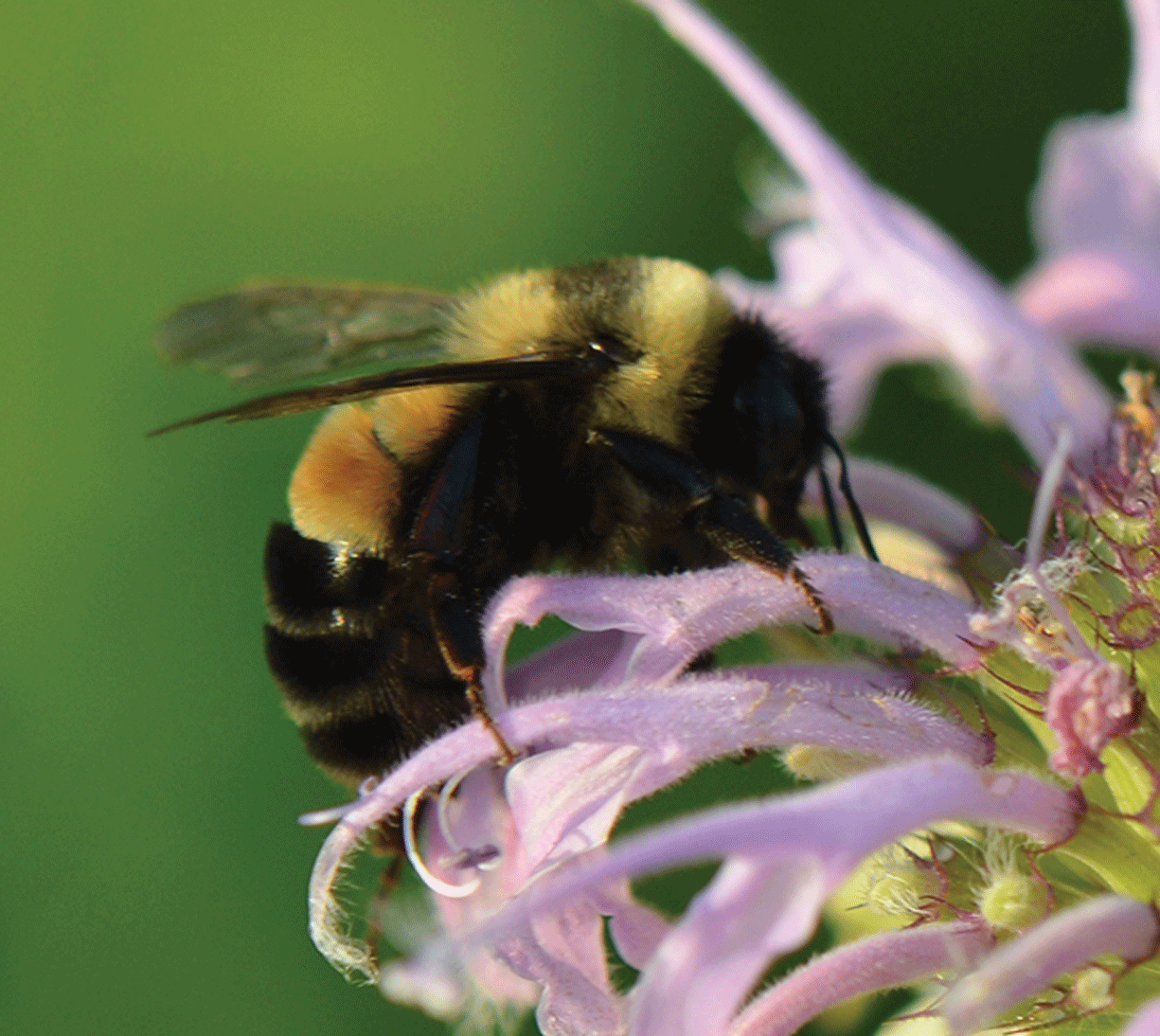
Rusty-patched bumble bee (Bombus affinis). Photograph by U.S. Fish and Wildlife Service.
Pollinator Monitoring and Research in National Wildlife Refuges
Pollinators are declining globally due to climate change, pesticide use, and habitat loss. Recent and rapid pollinator declines have generated conservation concerns resulting in petitions for listing of several pollinator species under the ESA and identification of regional at-risk insect species throughout the United States. The USFWS requested the USGS provide information on priority, at-risk pollinator species to inform effective management of National Wildlife Refuges (NWRs). The goal of this research project is to better understand the distribution and ecology of pollinators in NWRs in the eastern United States in relation to land management and climate gradients. To accomplish this objective, phenological habitat associations (such as, timing of use) of pollinators, effects of land-use and land-cover change from local to landscape scales on pollinator communities, and latitudinal variation in species distributions are being quantified in 10 NWRs, from Maine to Virginia. This project will provide information on the distribution and ecology of at-risk insect pollinator species and associated species (such as, Ashton’s cuckoo bumble bee [Bombus ashtoni]) across NWRs, thereby informing management for pollinators throughout the USFWS’s Northeast Region. Also, this project will investigate effects of a changing climate on pollinators and the potential for NWRs to serve as sources of pollinator populations on the landscape in the eastern United States.
Lead USGS Scientist, Steve Grodsky, (USGS New York Cooperative Fish and Wildlife Research Unit), Rachel Kelty (New York Cooperative Fish and Wildlife Research Unit), Tony Tur, Becky Longenecker, Cal Ritter, and Troy Wilson (USFWS)
Evaluating Trends and Projecting Future Conditions for Western and McKay’s Bumble Bees (Bombus occidentalis and Bombus mckayi)
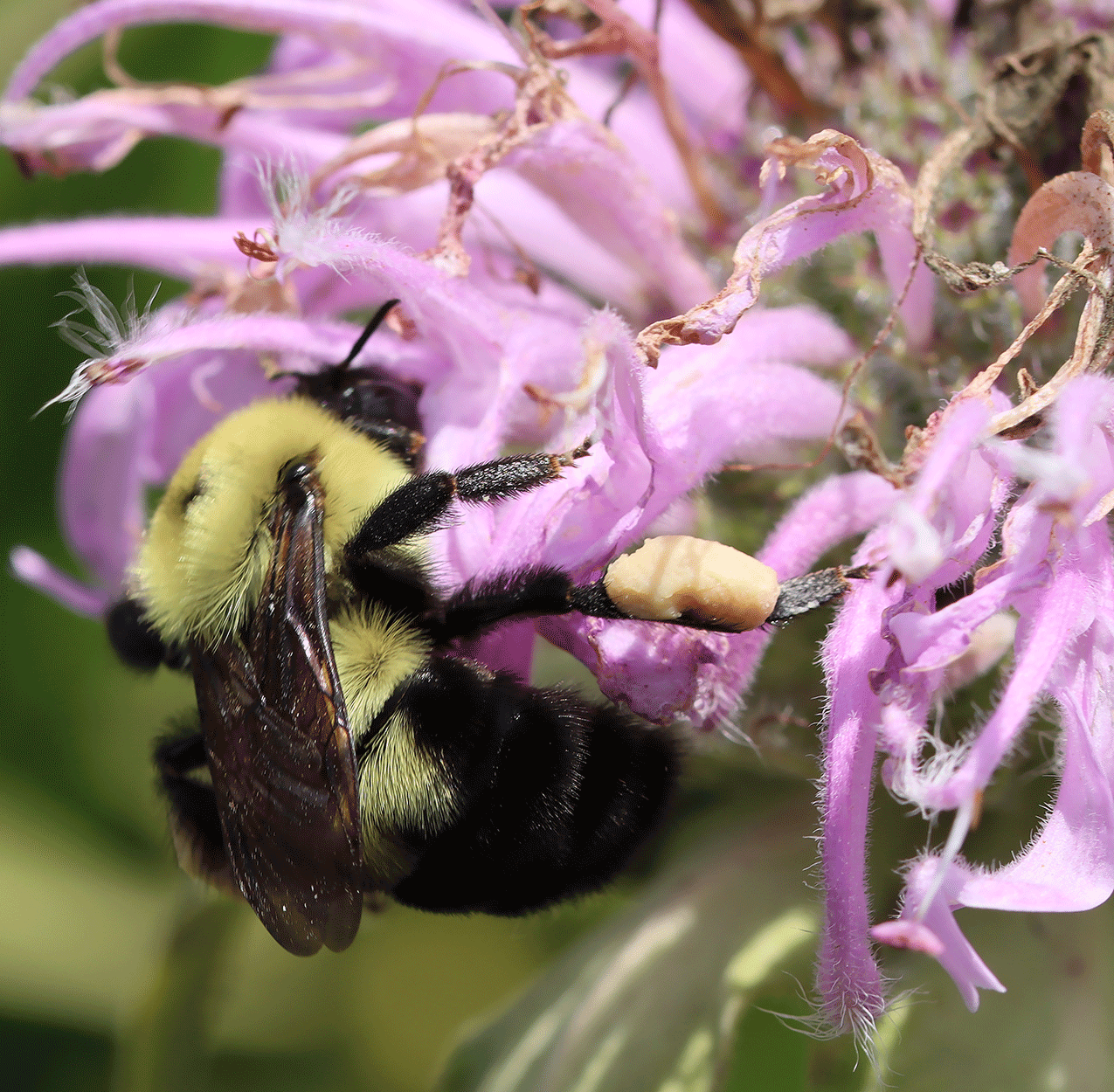
A female two-spotted bumble bee (Bombus bimaculatus) foraging on wild bergamot (Monarda fistulosa). Note the clump of pollen she is carrying on her right leg. Photograph by Debbie Koenigs, U.S. Fish and Wildlife Service.
The decline of pollinators has generated considerable conservation attention in recent years. To make effective management decisions, the USFWS engaged the USGS to conduct science to inform a Species Status Assessment which provides a summary of what is known about a species and is used as a foundation for listing decisions under the ESA. The USGS science team evaluated trends in western bumble bee occupancy across multiple ecoregions and developed a sampling design to address spatial gaps and guide future data collection They worked extensively with agency and university subject experts to prioritize and complete targeted research for western (Bombus occidentalis) and McKay’s (B. mckayi) bumble bees and conducted initial analyses to evaluate trends in occupancy (species presence or absence) based on indications of the species declining distributions (Graves and others, 2020). Integrating data from new sampling efforts, the team explained effects of multiple potential stressors on the western bumble bee to identify reasons for declines in occupancy, including climate, landcover, and pesticides (fig. 1; Janousek and others, 2023). The team’s results provided predictions of past and current distribution of the species, and indicated a mean predicted decline of ~57 percent across the western United States from 1998 to 2020. This analysis allowed the team to predict future distributions of the western bumble bee to the 2050s based on changes in climate, landcover, and other conditions. By using climate models that describe recent and future conditions in the western United States the scientists predicted future western bumble bee occupancy based on three scenarios that incorporated likely future conditions based on a suite of greenhouse gas emission levels. Future climate conditions ranged from drier and much warmer to wetter with less warming. Finally, landcover projections were paired with climate scenarios from best (most favorable) to worst (least favorable) according to their relation to the occupancy of the species. This application of occupancy models to pollinators identified methods to accommodate changes in the number of bees in a colony during the summer growing season while accounting for surveys that do not detect bees when they are present. Maps of predicted occupancy in 1998 and 2020, maps of future projections of occupancy in the 2050s, and predictive tools were developed by the team to identify the number of surveys needed to detect these species of concern in the future. Results on McKay’s bumble bees are forthcoming.
Tabitha Graves and Will Janousek, Lead USGS Scientists (Northern Rocky Mountain Science Center), Jeff Everett, Doug Keinath, Marion Clément (USFWS), Margaret Douglas (Dickinson College), Syd Cannings (Canadian Wildlife Service), Casey Delphia (Montana State University), Rich Hatfield, Leif Richardson (Xerces Society), Jon Koch, Lindsie McCabe, Ashley Rohde (U.S. Department of Agriculture-Agricultural Research Service), John Mola (USGS Fort Collins Science Center), Jane Ogilvie (Rocky Mountain Biological Laboratory), Imtiaz Rangwala (North Central Climate Adaptation Center, University of Colorado-Boulder), Jamie Strange (Ohio State University), and Lusha Tronstad (University of Wyoming)
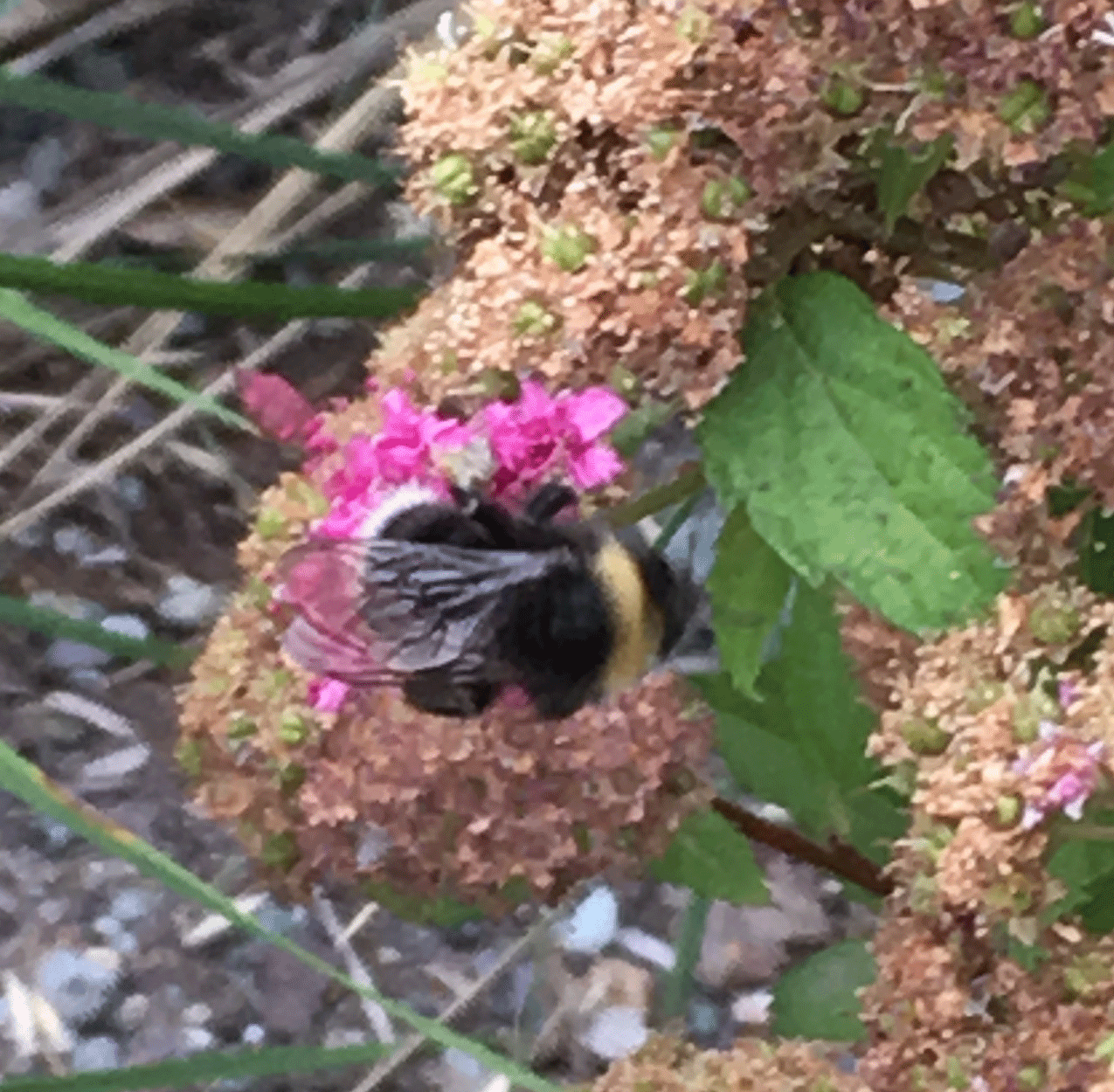
Western bumble bee (Bombus occidentalis).
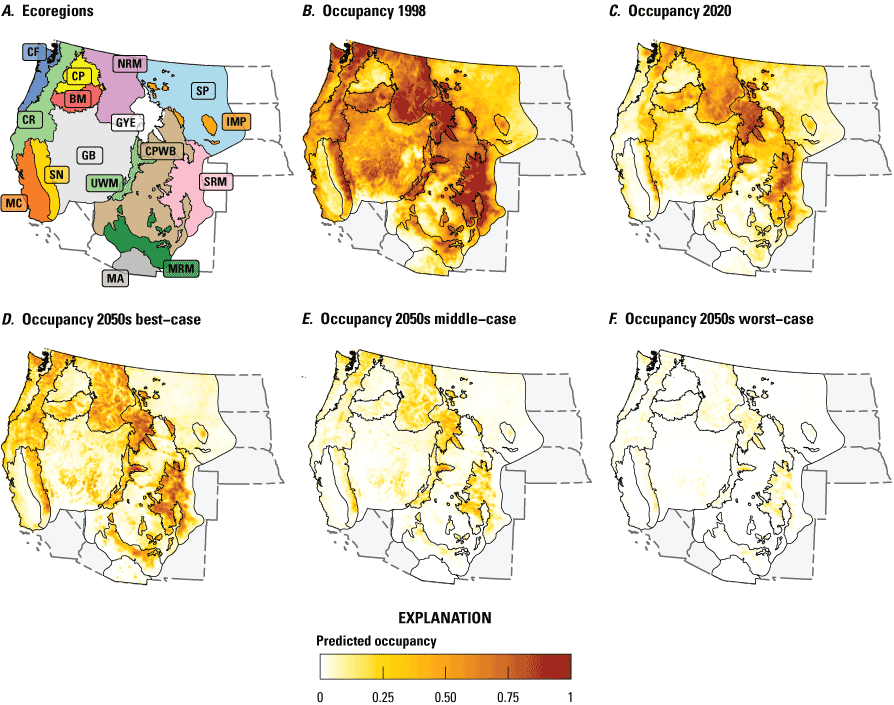
Maps of the western conterminous United States to represent A, ecoregions where Bombus occidentalis is extant, B, mean predicted occupancy in 1998, C, mean predicted occupancy in 2020, D, predicted changes in the occupancy of B. occidentalis under a best-case climate change scenario, E, predicted changes in the occupancy of B. occidentalis under a middle-case climate change scenario, and F, predicted changes in the occupancy of B. occidentalis under a worst-case climate change scenario. Blue Mountains (BM), Cascade Range (CR), Coastal Forest (CF), Colorado Plateau and Wyoming Basin (CPWB), Columbia Plateau (CP), Great Basin (GB), Greater Yellowstone Ecosystem (GYE), Isolated Mountains in Prairie (IMP), Mediterranean California (MC), Northern Rocky Mountains (NRM), Southern Rocky Mountains (SRM), Semi-arid Prairies (SP), Sierra Nevada (SN), Uinta and Wasatch Mountain (UWM), Mogollon Rim and Mountains (MRM), Madrean Archipelago (MA). Figure is from Janousek and others (2023); Copyrighted (2023) National Academy of Sciences.
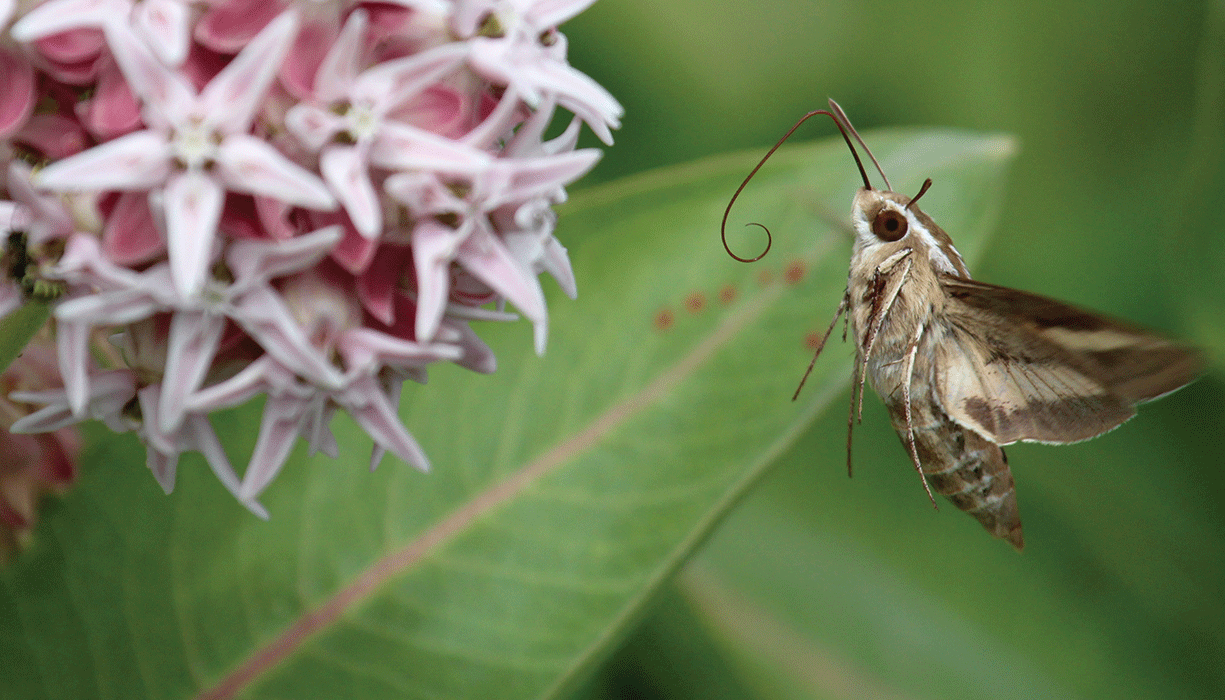
Hummingbird moth (Macroglossum spp.) landing on milkweed (Asclepias spp.). Photograph by Judy Johnson, U.S. Fish Wildlife Service.
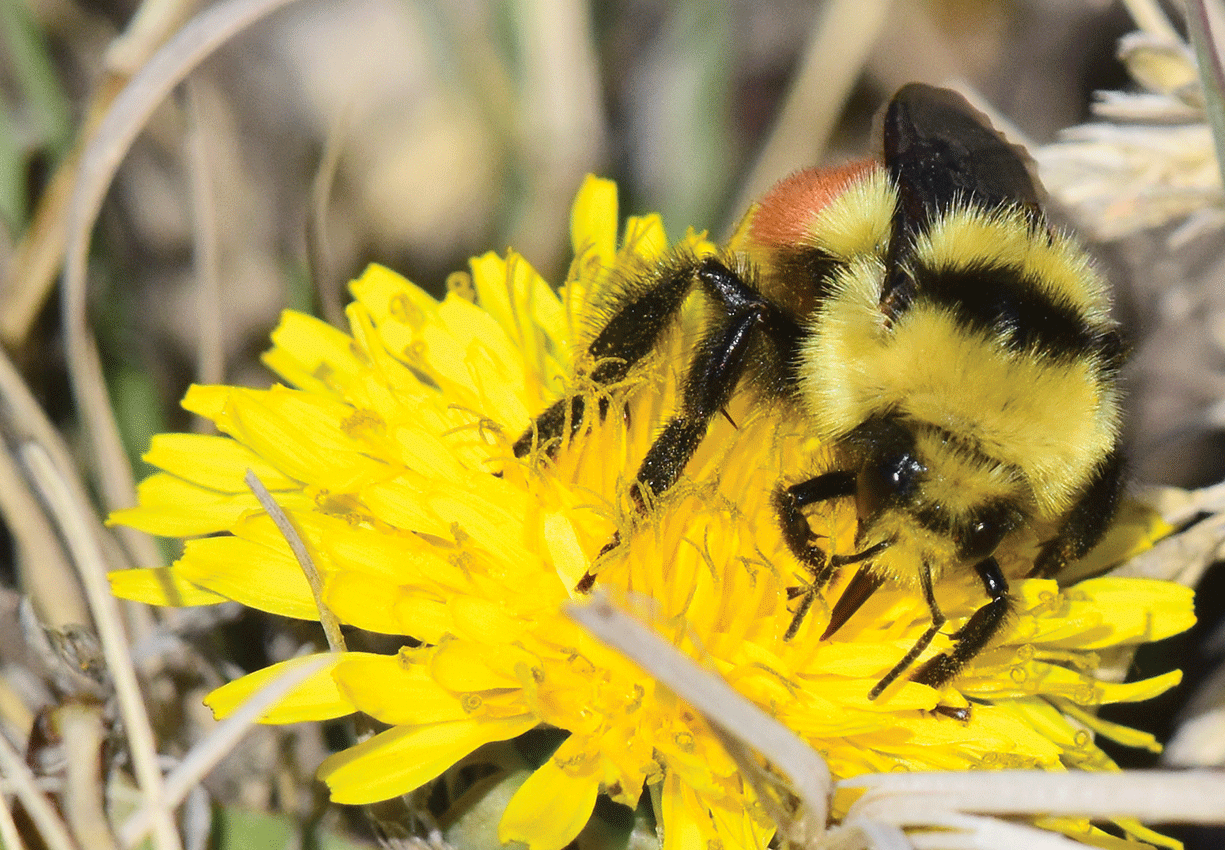
Hunt’s bumble bee (Bombus huntii) on dandelion (Taraxacum officinale). Photograph by Tom Koerner, U.S. Fish Wildlife Service.
Enhancing Climate Adaptation for Native Communities in Western Alaska: Linking Pollinator Diversity and Abundance to Berry Production in a Rapidly Changing Environment
The Bees and Berries project is a partnership with Alaska Native scientists, educators, and students, provides information on the ecology, diversity, and vulnerability of arctic pollinators. In subarctic and arctic ecosystems, berry-producing plants are an essential component of the landscape (Herman-Mercer and others, 2020). Berry-producing plants, such as cloudberry (Rubus chamaemorus), are a primary subsistence resource for Alaska Native communities and have been integral to maintaining cultural cohesion, sense of place, and physical ties to the surrounding landscape for more than 3,000 years (Herman-Mercer and others, 2020). Despite the importance of berry-producing plants, relatively little is known about their vulnerability to ongoing environmental change, and even less is known about how and where changing climate and other disturbances may impact their insect pollinators. Because pollinators play a major role in maintaining natural communities and facilitating recovery after disturbance events, a change in pollinator abundance or phenology (such as, timing of emergence, reproduction, and other life history events) may have major and cascading effects on annual berry production, ecosystems, and human community resilience. This project includes insect pollinator identification via collection and genetic methods, vegetation and land cover assessment, and incorporation of traditional knowledge on plant-pollinator dynamics.
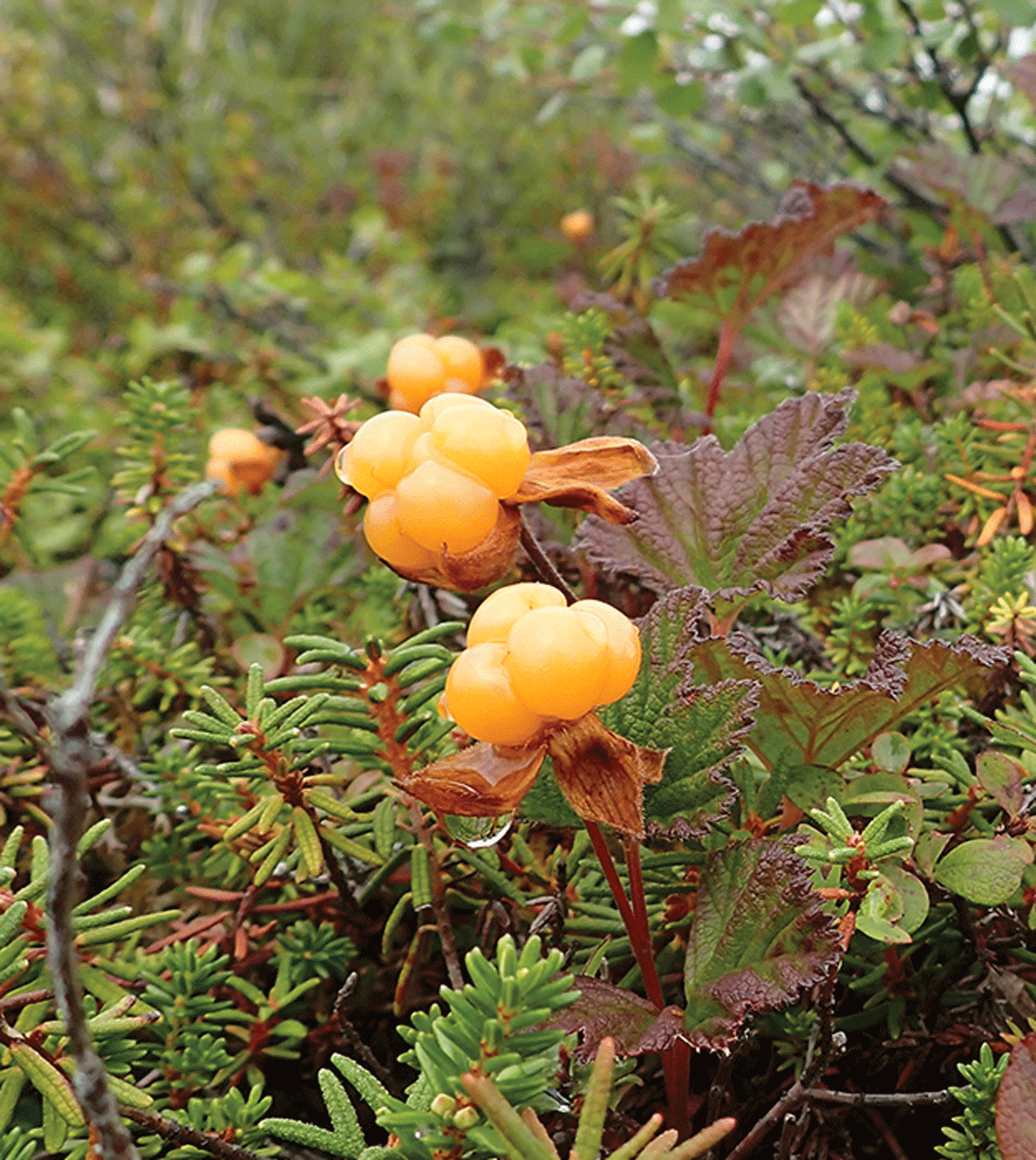
Photo of Cloudberries (Rubus chamaemorus).
Lead USGS Scientist, Rachel Loehman, (Alaska Science Center) with support from the Alaska CASC; Partners are Elizabeth M. Powers (Office of the Alaska Regional Director), Matthew Carlson (University of Alaska Anchorage), Mark Davis (University of Illinois Urbana-Champaign), E. Jamie Trammell (Southern Oregon University), Cynthia Paniyak (Chevak Traditional Council), and Victor Tonuchuk (Kotlik Tribal Council)
References Cited
Committee on the Status of Pollinators in North America, 2007, Status of Pollinators in North America: Washington D.C., National Academy Press, 312 p., accessed May 6, 2023, at https://nap.nationalacademies.org/read/11761/chapter/1.
Dicks, L.V., Viana, B., Bommarco, R., Brosi, B., Arizmendi, M.D.C., Cunningham, S.A., Galetto, L., Hill, R., Lopes, A.V., Pires, C., Taki, H., and Potts, S.G., 2016, Ten policies for pollinators: Science, v. 354, no. 6315, p. 975–976, accessed June 2, 2023, at https://doi.org/10.1126/science.aai9226.
Graves, T.A., Janousek, W.M., Gaulke, S.M., Nicholas, A.C., Keinath, D.A., Bell, C.M., Cannings, S., Hatfield, R.G., Heron, J.M., Koch, J.B., and Loffland, H.L., 2020, Western bumble bee: declines in the continental United States and range‐wide information gaps: Ecosphere, v. 11, no. 6, 13 p., accessed June 9, 2023, at https://doi.org/10.1002/ecs2.3141.
Herman-Mercer, N.M., Loehman, R.A., Toohey, R.C., and Paniyak, C., 2020, Climate-and disturbance-driven changes in subsistence berries in coastal Alaska—Indigenous knowledge to inform ecological inference: Human Ecology: an Interdisciplinary Journal, v. 48, no. 1, p. 85–99, accessed May 23, 2023, at https://doi.org/10.1007/s10745-020-00138-4.
Inouye, D., Droege, S., and Mawdsley, J., 2017, Words alone will not protect pollinators: Science, v. 355, no. 6323, p. 357–357, accessed May 31, 2023, at https://doi.org/10.1126/science.aam6132.
Janousek, W.M., Douglas, M.R., Cannings, S., Clément, M.A., Delphia, C.M., Everett, J.G., Hatfield, R.G., Keinath, D.A., Koch, J.B.U., McCabe, L.M., Mola, J.M., Ogilvie, J.E., Rangwala, I., Richardson, L.L., Rohde, A.T., Strange, J.P., Tronstad, L.M., and Graves, T.A., 2023, Recent and future declines of a historically widespread pollinator linked to climate, land cover, and pesticides: Proceedings of the National Academy of Sciences of the United States of America, v. 120, no. 5, p. 1–9, accessed May 23, 2023, at https://doi.org/10.1073/pnas.2211223120.
Klein, A.M., Vaissière, B.E., Cane, J.H., Steffan-Dewenter, I., Cunningham, S.A., Kremen, C., and Tscharntke, T., 2007, Importance of pollinators in changing landscapes for world crops: Proceedings. Biological Sciences, v. 274, no. 1608, p. 303–313, accessed May 31, 2023, at https://doi.org/10.1098/rspb.2006.3721.
Potts, S.G., Biesmeijer, J.C., Kremen, C., Neumann, P., Schweiger, O., and Kunin, W.E., 2010, Global pollinator declines—Trends, impacts and drivers: Trends in Ecology and Evolution, v. 25, no. 6, p. 345–353, accessed May 31, 2023, at https://doi.org/10.1016/j.tree.2010.01.007.
For more information, contact:
USGS Ecosystems Mission Area
12201 Sunrise Valley Drive
Reston, Virginia 20192
For additional information about this and other pollinator research conducted by the USGS, visit https://www.usgs.gov/pollinators
All photographs by the U.S. Geological Survey or where noted, by the U.S. Fish and Wildlife Service.
Suggested Citation
Irwin, E., and Mawdsley, J., 2023, Pollinator conservation and climate science at the U.S. Geological Survey: U.S. Geological Survey Fact Sheet 2023–3026, 4 p., https://doi.org/10.3133/fs20233026.
ISSN: 2327-6932 (online)
| Publication type | Report |
|---|---|
| Publication Subtype | USGS Numbered Series |
| Title | Pollinator conservation and climate science at the U.S. Geological Survey |
| Series title | Fact Sheet |
| Series number | 2023-3026 |
| DOI | 10.3133/fs20233026 |
| Year Published | 2023 |
| Language | English |
| Publisher | U.S. Geological Survey |
| Publisher location | Reston, VA |
| Contributing office(s) | Cooperative Research Unit Atlanta |
| Description | 4 p. |
| Online Only (Y/N) | Y |
| Additional Online Files (Y/N) | N |
| Google Analytic Metrics | Metrics page |


